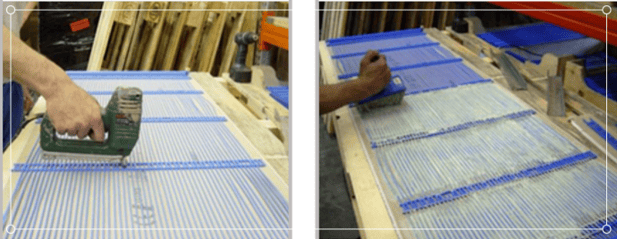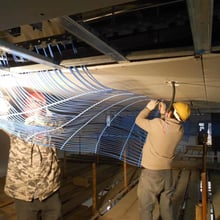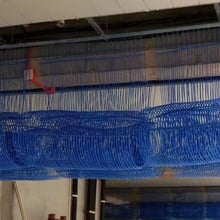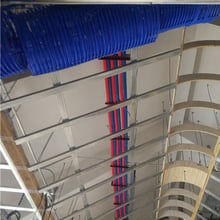SINOLANC radiant ceiling system can not only be used for cooling, but also for energy-efficient heating. The implementation of ceiling heating and cooling in one system reduces operating costs.
Capillary tube mats can be installed either in or on the ceiling constructions. Due to the small outer diameter of the capillary tubes and their high degree of flexibility, capillary tube mats can also be plastered directly onto the bare concrete ceiling. Even the vaulted and curved ceiling structures is possible with capillary tube technology.
Heating capillary tube mats installed close to the ceiling surface, this minimizes the thermal resistance from the heating water to the thermally activated surface. It can be operated with low supply temperature, which are only slightly above the room temperature. The result is high energy efficiency.
PLASTER ON CONCRETE CEILING
Smooth surfaces, Excellent heating and cooling performance, Design comfort.
SINOLANC RADIANT CEILING HEATING & COOLING
Cooling radiant ceilings provide a high level of acceptance and satisfaction among users. In summer, the ceiling cooling supplies a uniform temperature reduction without the disruptive effects of air conditioning such as cold air circulation and annoying noise.
For cooling purposes, SINOLANC Capillary Tube Mats are preferentially installed either in or on the ceiling; in this case the surface temperature of the ceiling is, depending on the supply temperature, approx. 19 °C at only 2 to 3 K spreading between supply and return (supply temperature = usually 16 °C; return temperature = 18 °C or 19 °C). Depending on the type of ceiling or the way the capillary tube mats are installed, cooling capacities of up to 100 W/m² (Δ=10 K) can be achieved for closed radiant cooling ceilings.
FEATURES
Heating and cooling with one system
Low installation height
Even heat distribution
Directly perceptible radiant heating
Low air circulation, healthy indoor climate
Silent system without annoying radiators
Low energy cost









Sinolanc capillary tube mats with plaster ceilings are popular because of their simple appearance and installation. The capillary tube mats are plastered directly underneath a concrete ceiling, which invisibly integrated into the ceiling not only provide excellent cooling in the summer, but can also be used to heat comfortably and energy-efficient. The renovation of plaster ceilings does not require much effort.
A complete embedding of the capillary tubes is achieved with a spraying plaster layer thickness of 10-15 mm. Mat distributor pipes and supply lines are accommodated in the a slot or void of the ceilings. A large-area and even heat conduction is achieved.
Due to the ceiling construction is thinner than 15mm, the heat exchange between the mats and the plaster surface is intensive to ensures a rapidly heat-up or cool-down. The water circulates noiselessly in the capillary tube mats and regulates the room temperature largely by radiation, partly by convection. The plaster cooling ceilings achieve impressively high heating and cooling capacities.
PREFABRICATED GYPSUM BOARD PANEL WITH AN INTEGRATED CAPILLARY TUBE MATS
The capillary tube mats are screwed or with thermally conductive paste onto the suspended prefabricated gypsum board panel. The capillary tube mats connected to a hydraulic circuit, and to the supply and return lines, which are located in the void of the suspended ceiling, by heating element socket welding.


DRYWALL CEILING WITH CAPILLARY TUBE MATS






The light capillary tubes lie directly on the top side of the plasterboard and thus pass on the heat without much loss. The low weight of an applied mineral wool insulation reinforces this effect.
Ceiling Cooling or Heating In Drywall with quick installation:
Installation of the substructure and a distance about 100 mm need be left between the support profile and the wall connection profile for inserting the capillary tube mats.
The main supply and return lines installation for the capillary tube mats in the ceiling void.
Hook in the retainers or retaining clips between the support profiles.The capillary tube mats are fixed between the support profiles of a suspended drywall ceiling with retaining brackets or retaining clips.
DEW POINT IN COOLING MODE
Surface cooling systems bear the risk of dew point exceedance and of condensation on the cold surface. This risk can be safely ruled out! Therefore each control zone is equipped with one or several dew point sensors. To avoid condensation on the cooling surface, in case of a dew point risk the flow through the capillary tube mats is stopped by closing the control valve. Switching off the individual zones can be counteracted by using an enthalpy-based supply temperature control.
In large and intensively used office buildings cooling ceilings are often combined with a supporting ventilation system, so that dew point exceedance happens very rarely. This is necessary as a rule in order to provide all users with the required fresh air as well as to remove the bad air. The relative humidity is controlled by ventilation and maintained at a comfortable and within dew point non-critical range.
For this reason, cooling ceiling technology has been popular used in large office and administration buildings successfully for many years

CONTACTS
P: +86 18920696269
E: energy@snlanc.com
ADDRESS
Sales Office : Floor 1-2 Henghua Building, Dagu South Street, Hexi District, Tianjin
Factory: No.6 Innovation Technology Park, Dongli District, Tianjin, China
Copyright © 2024 SINOLANC ENERGY
